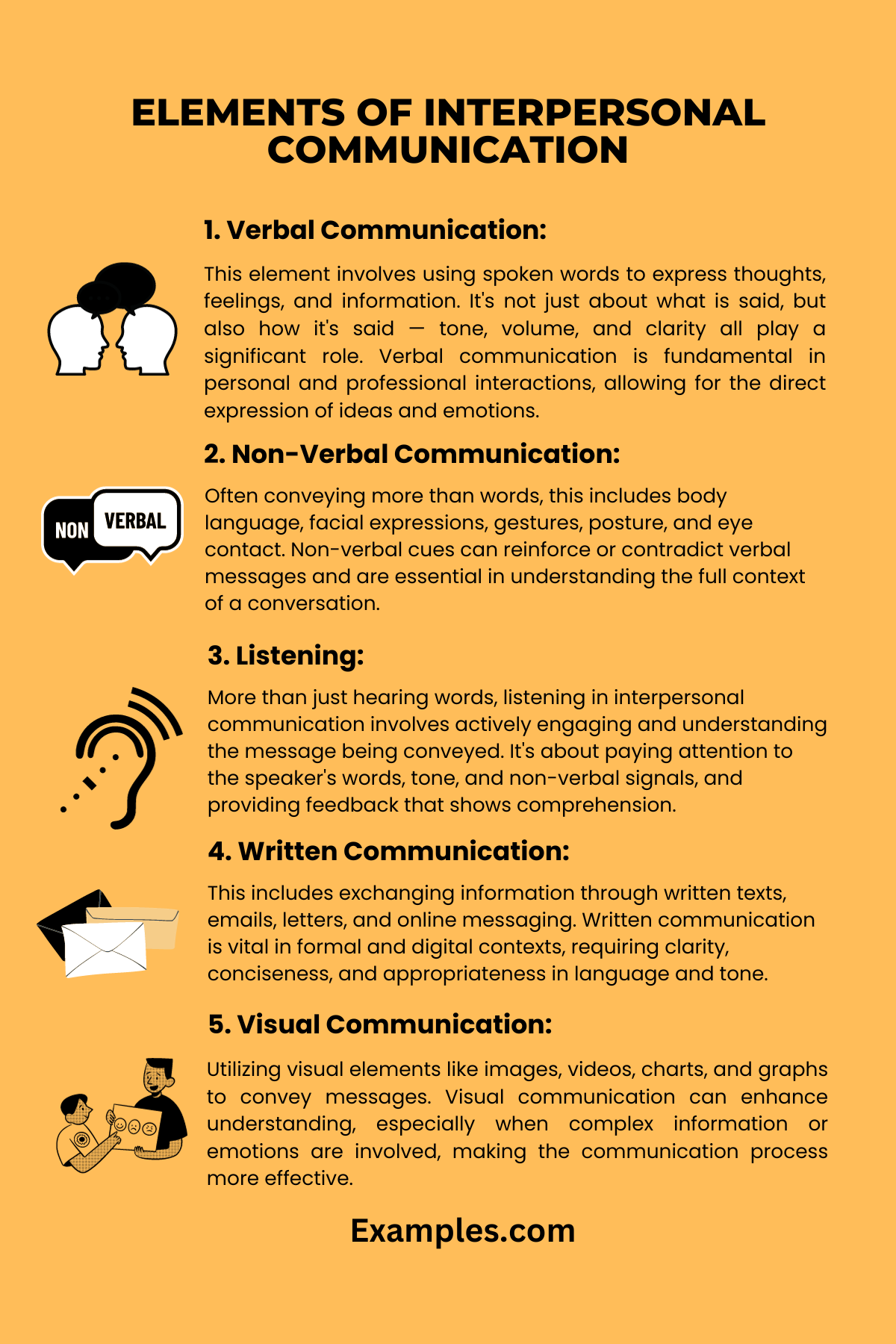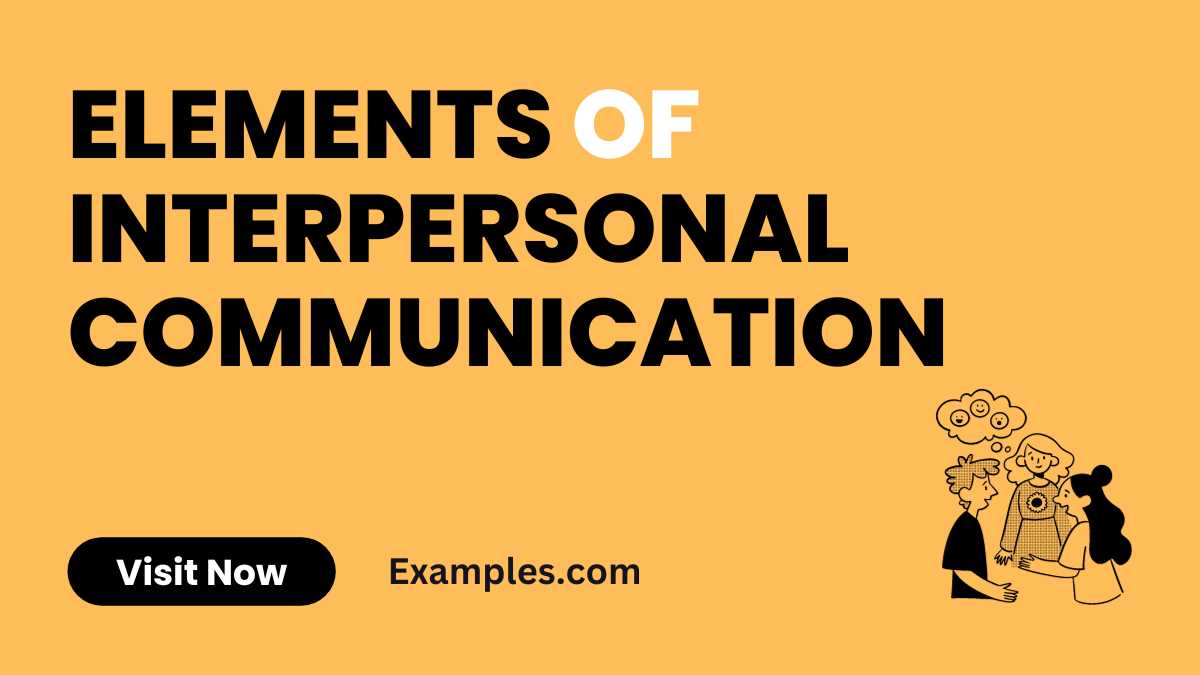Elements of Interpersonal Communication – 9+ Examples
Interpersonal communication, the cornerstone of successful relationships, is an intricate blend of verbal and non-verbal cues. Our guide delves into the Elements of Interpersonal Communication, offering a comprehensive understanding of this vital skill. Through vivid Interpersonal Communication Examples, learn how these elements function in everyday life. From expressions and gestures to digital nuances, we explore the multifaceted nature of personal interactions, equipping you with the tools to communicate more effectively in various settings.
What are the Elements of Interpersonal Communication? – Definition
Interpersonal communication is a multifaceted process involving the exchange of messages between people to share information and feelings. It encompasses various forms, including Verbal Communication in Interpersonal Communication, where spoken words are used, and Non-Verbal Communication in Interpersonal Communication, which relies on body language and facial expressions. Additionally, Written Communication in Interpersonal Communication plays a crucial role, especially in our digital age where emails and texts are common. Listening in Interpersonal Communication is equally important, as it involves understanding and interpreting messages accurately. The elements of interpersonal communication are integral to forming connections, resolving conflicts, and navigating the complexities of human interactions in personal and professional settings.
10 Elements of Interpersonal Communication

Interpersonal communication is a dynamic and multifaceted process. Key elements include Verbal Communication, where words convey messages, and Non-Verbal Communication, involving body language and gestures. Listening is essential for understanding, while Written Communication covers texts and emails. Visual Communication relies on images and videos. Emotional Expression conveys feelings, and Small Group Communication focuses on interactions within groups. Public Communication involves speaking to larger audiences, and Digital Communication utilizes online platforms. Lastly, Interpersonal Conflict Communication deals with resolving disagreements. These elements are vital in shaping effective personal and professional interactions.
- Verbal Communication: This element involves using spoken words to express thoughts, feelings, and information. It’s not just about what is said, but also how it’s said — tone, volume, and clarity all play a significant role. Verbal communication is fundamental in personal and professional interactions, allowing for the direct expression of ideas and emotions.
- Non-Verbal Communication: Often conveying more than words, this includes body language, facial expressions, gestures, posture, and eye contact. Non-verbal cues can reinforce or contradict verbal messages and are essential in understanding the full context of a conversation.
- Listening: More than just hearing words, listening in interpersonal communication involves actively engaging and understanding the message being conveyed. It’s about paying attention to the speaker’s words, tone, and non-verbal signals, and providing feedback that shows comprehension.
- Written Communication: This includes exchanging information through written texts, emails, letters, and online messaging. Written communication is vital in formal and digital contexts, requiring clarity, conciseness, and appropriateness in language and tone.
- Visual Communication: Utilizing visual elements like images, videos, charts, and graphs to convey messages. Visual communication can enhance understanding, especially when complex information or emotions are involved, making the communication process more effective.
- Emotional Expression: Sharing and interpreting emotions is a crucial part of interpersonal communication. It involves understanding emotional cues and responding appropriately. Emotional expression helps in building empathy and deeper connections.
- Small Group Communication: This occurs within small groups, where interaction dynamics and individual roles significantly influence the communication process. It involves coordinating and sharing information, resolving conflicts, and making decisions collectively.
- Public Communication: Involves speaking to larger audiences, requiring skills in clarity, organization, engagement, and often persuasion. Public communication is key in situations like presentations, speeches, and public announcements.
- Digital Communication: Refers to communication through digital platforms such as social media, online forums, emails, and virtual meetings. It’s increasingly important in today’s digitalized world, necessitating an understanding of different digital communication norms and etiquette.
- Interpersonal Conflict Communication: Managing and resolving disagreements effectively is a crucial element. It involves understanding different perspectives, negotiating, and finding mutually acceptable solutions, crucial for maintaining healthy and productive relationships.
Elements of Interpersonal Communication Skills

Exploring the Elements of Interpersonal Communication Skills is crucial for anyone looking to enhance their ability to connect and communicate effectively. These skills are vital in various contexts, from Interpersonal Communication at the Workplace to personal relationships. They encompass not just speaking and listening but a broad spectrum of abilities essential for Effective Interpersonal Communication. Here, we delve into each of these elements, highlighting their importance in everyday interactions and professional settings.
- Active Listening: Integral to Listening in Interpersonal Communication, this involves fully engaging with the speaker, understanding their message beyond words, and responding thoughtfully.
- Clear Expression: A key component of Verbal Communication in Interpersonal Communication, it entails articulating thoughts and emotions clearly and effectively, using appropriate language and tone.
- Empathy: Central to Emotional Expression in Interpersonal Communication, it involves understanding and sharing the feelings of others, fostering deeper connections.
- Feedback: In Interpersonal Communication Skills, giving and receiving constructive feedback is crucial for growth and improvement in any communicative context.
- Conflict Resolution: A vital skill in Interpersonal Conflict Communication, it involves managing disagreements constructively and finding amicable solutions.
- Adaptability: Essential for Styles of Interpersonal Communication, this skill is about adjusting communication styles to suit different situations and people.
- Non-Verbal Awareness: A crucial part of Non-Verbal Communication in Interpersonal Communication, understanding body language and facial expressions enhances the overall communication process.
Key Elements of Interpersonal Communication

Understanding the Key Elements of Interpersonal Communication is essential for effective exchange and interpretation of messages. These elements form the foundation of communication in various settings, from personal interactions to Interpersonal Communication in Business environments. Recognizing these elements helps in enhancing Interpersonal Communication Skills, making interactions more effective and meaningful.
- Sender and Receiver: The core participants in any communication process, playing alternating roles of sending and receiving information.
- Message: The substance of communication, encompassing ideas, feelings, or information, vital in Types of Interpersonal Communication.
- Channel: The medium used, such as verbal, non-verbal, or digital, crucial in Digital Communication in Interpersonal Communication.
- Feedback: Responses that indicate understanding or misunderstanding of the message, a key part of the Principles of Interpersonal Communication.
- Context: The backdrop against which communication happens, including cultural, social, and emotional environments, influencing Perception in Interpersonal Communication.
- Noise: Distractions or barriers that hinder effective communication, an important consideration in Requirements for Interpersonal Communication.
Basic Elements of Interpersonal Communication
The Basic Elements of Interpersonal Communication are fundamental components that facilitate effective message exchange. Understanding these elements is crucial for anyone aiming to improve their Interpersonal Communication Skills and is especially relevant in contexts like Interpersonal Communication in Nursing and Interpersonal Communication in Relationships. These elements are the building blocks of all forms of interpersonal exchanges.
- Verbal Communication: Central to Verbal Communication in Interpersonal Communication, involving spoken or written words for message conveyance.
- Non-Verbal Communication: Includes body language and facial expressions, crucial in Non-Verbal Communication in Interpersonal Communication, providing context to verbal messages.
- Listening: An essential skill in Listening in Interpersonal Communication, it’s about understanding the message’s content and emotional undertone.
- Feedback: The response that shapes subsequent communication, a critical aspect of Effective Interpersonal Communication.
- Context: The environment or setting, which greatly influences how messages are sent, received, and interpreted in various Types of Interpersonal Communication.
In conclusion, understanding the Elements of Interpersonal Communication is key to effective interactions. This guide has provided insights into essential communication skills, key and basic elements, along with practical tips. By mastering these components, individuals can enhance their personal and professional relationships, ensuring clear, empathetic, and effective exchanges in various communication scenarios.



